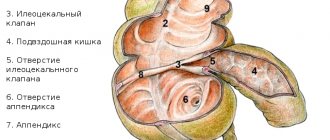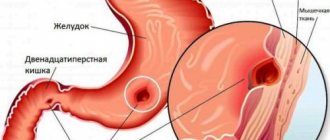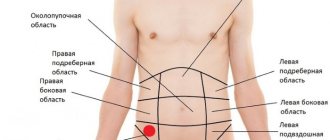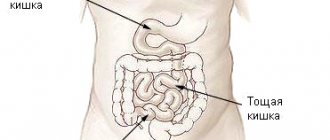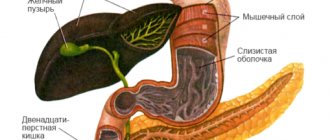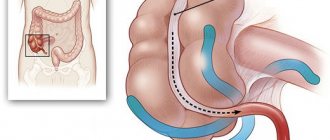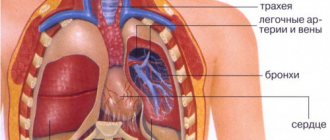The text is presented for informational purposes only. We strongly urge you not to self-medicate. When the first symptoms appear, consult a doctor. We recommend reading: “Why you can’t self-medicate?”
The ileum refers to the lower part of the small intestine and is located on the lower right side of the abdominal cavity. The separation of the intestine from the cecum is carried out by the Bauhinium valve. The arrangement of the organ loops occurs in two planes: the lower ones are located horizontally, and the upper ones are vertical.
Structure
Due to the fact that the jejunum and ileum are covered by peritoneum and have a common mesentery, many experts consider them as one organ. Thanks to the mesentery, fixation to the posterior abdominal wall occurs.
Medical products (drugs, medicines, vitamins, dietary supplements) are mentioned for informational purposes only. We strongly do not recommend using them without a doctor's prescription. We recommend reading: “Why can’t you take medications without a doctor’s prescription?”
It is a hollow organ that is lined with smooth muscles. The average length of the organ in humans ranges from 1.3 to 2.6 m. Moreover, in men the intestine is slightly longer than in women.
The inner layer of the intestine is covered with raised villi, which consist of columnar epithelium. Due to the presence of crypts and circular folds, there is a significant increase in the total surface of the intestinal lining, thereby improving the absorption of digested food. Crypts are depressions in the shell that are shaped like tubes.
We care about your health
Diseases of the large intestine do not always manifest themselves clearly and clearly. More often than not, the initial phase is accompanied by vague symptoms that people do not attach importance to. This may be a burning sensation, discomfort in the intestines, and periodic mucus discharge. The specificity of the intestines is that for a long time it may not give such signs that would indicate the need to visit a proctologist. Even when a person begins to be bothered by pain, bloating, discharge from the anus and other symptoms, he does not rush to see a doctor. At first, the patient persistently tries self-medication and those remedies that modern advertising intrusively offers. Meanwhile, the symptoms change, become more noticeable, painful and often aggressive.
Sometimes the symptoms may not indirectly indicate intestinal diseases; the symptoms may be specific:
- sudden weight loss;
- weakness in the body;
- disturbances in metabolic and hormonal processes;
- hair loss.
These signs accompany the most severe intestinal lesions: cancer, malignant tumors, polyposis. The intestine is the only organ that simultaneously belongs to two important systems of the body: the immune and gastrointestinal tract. For a full life and health, it is important to be able to recognize those symptoms and signs that indicate a pathological process in the large intestine:
- constipation;
- pain of varying intensity in the abdomen;
- bleeding during bowel movements;
- discharge of clear or purulent mucus;
- anemia;
- flatulence;
- intestinal obstruction;
- stool disorder;
- tenesmus;
- incontinence.
Intestinal constipation With constipation, difficulties with defecation are observed, up to the complete exclusion of stool for several days. Constipation can be constant and persistent and not respond to the effects of laxatives. An upset bowel movement can be replaced by constipation - this is a common picture with irritable bowel syndrome, dysbacteriosis, and functional disorders. The intensity of pain depends on the type of constipation: atonic and spastic. In the first case, the pain is aching, often not aggressive. With spastic constipation, there may be persistent pain in the groin area. The presence of frequent constipation indicates the possibility of fecal impaction or intestinal obstruction. The conditions are extremely dangerous in nature and can threaten life.
Abdominal pain Pain in the abdomen and groin often accompanies organic and functional disorders in the large intestine. Thus, with Crohn's disease and ulcerative colitis, the pain is in the nature of spastic contractions. Such pain often radiates to the lumbar region and radiates along the outside of the legs. It is difficult to determine the locality, since the pain “spreads” across the lower abdomen, often involving the perineum in the process.
Constant pain is a sign of a progressive inflammatory process. Such pains are aching, pulling, persistent. Manifested in IBS, various colitis, diverticulosis. The nature of the pain indicates the likelihood of developing peritonitis or a purulent lesion.
Bloody discharge and bleeding Bleeding occurs in diseases of the rectum and colon. Usually, the location of the lesion is visually determined by the color of the blood: the brighter the blood, the closer to the exit the lesion is. Thus, the appearance of clear and bright scarlet blood indicates internal or external hemorrhoids. Sometimes blood loss can be significant and cause weakness and dizziness.
If the stool is homogeneous and contains uniform bloody impurities, then this is a symptom of the formation of a tumor in the upper intestines. Sometimes such masses occur with nonspecific colitis and diverticulosis. The higher the lesion is, the more uniform the blood clots in the stool will look and the darker their color.
In Crohn's disease, blood may be released in pure form or in large clots. In some cases, scarlet blood may be a sign of a disintegrating tumor in the intestine.
Discharge of mucus or pus Such discharge is either constant or appears during bowel movements. Most often this becomes a sign of the formation of a fistula in the anus. With constant mucus secretion and pain, sphincter insufficiency can be assumed. In this case, numerous erosions and cracks form, which causes itching and pain.
Such discharge is characteristic of irritable bowel syndrome, proctitis, and the formation of tumors in the sigmoid colon. Often the discharge is combined with blood and the appearance of clots.
Pain in the anus Pain can be aching and periodic, bursting in the area of the passage. This happens with deep cracks; they heal with difficulty, especially if there is constipation. Jerking and unbearable pain occurs when hemorrhoids rupture or there are multiple nodes in the intestines. Regular hemorrhoids without complications do not cause such pain; they are only felt as distension and swelling in the anus.
Anemia Anemia develops when a person has lost a lot of blood. This occurs with severe intestinal lesions, cancerous formations, and rapid tumor progression.
Bloating and flatulence Bloating is a common sign for almost any pathology in the gastrointestinal tract. The feeling of bloating and heavy gases is typical with constipation, intestinal obstruction, and fecal impaction. Often flatulence is the result of enzyme deficiency and may indicate disturbances in the functioning of other internal organs. Bloating and flatulence often accompany those who suffer from dysbiosis and eat poorly. In some cases, bloating occurs with a feeling of discomfort and heaviness in the stomach, but with excess gas, severe abdominal pain may occur.
Intestinal obstruction Intestinal obstruction can be complete or partial. More often you have to deal with partial, which is characterized by:
- bloating;
- pain;
- flatulence;
- prolonged constipation;
- the appearance of impurities and blood;
- vomit;
- loss of appetite.
More often this indicates severe damage to the large intestine of organic origin. The condition is extremely painful and dangerous to human health. As it progresses, signs of poisoning of the body and inflammation of the peritoneum appear. With partial intestinal obstruction, stool is rare, scanty, and often replaced by profuse upset. Temporary improvement occurs under the influence of taking laxatives or cleansing enemas.
Stool disorder Diarrhea accompanies milder intestinal diseases, a common sign of dysbiosis. Also, stool disorder can be combined with other symptoms, such as constipation or various discharges. This happens with exacerbation of colitis, IBS.
Tenesmus Tenesmus is a false urge to have a bowel movement. With such urges, a small amount of mucus is released, sometimes along with diarrhea. Tenesmus is usually frequent, persistent, tiring a person with its frequency. Characteristic of excited motility of the rectum, they become a consequence of inflammation of the mucous membrane of the anus.
Incontinence Incontinence of fecal masses of secreted gases manifests itself with congenital or acquired changes in the sphincter. Another reason could be dysregulation due to psychological factors.
Functions
- Secretory. The organ secretes intestinal juice in a volume of 2.4-2.6 liters. This juice contains special substances - enzymes that take part in the breakdown of food: lipase, peptidase, alkaline phosphatase, etc.;
- Suction. In this section, the absorption of the final products of digestion (monosaccharides, amino acids and lipids) and vitamin B12 occurs;
- Motor. Due to the contraction of muscle fibers, the movement of food gruel is noted.
Be sure to read:
Jejunum: location, structure and functions
What is colon cancer?
Colon cancer is formed from the mucous membrane and is malignant in nature. Adenocarcinoma is more common, squamous cell carcinoma is less common.
In most cases, a malignant neoplasm is formed as a result of the transformation of polyps that have arisen in the colon. Thus, timely removal of polyps reduces the likelihood of developing cancer and is a surgical prevention of cancer.
A colon tumor forms in one of its sections:
- Cecum
- Ascending colon
- Transverse colon
- Descending colon
- Sigmoid colon
Despite the possibility of cancer forming in any part of the colon, the incidence of lesions in each area varies significantly. Thus, in 50% of cases, the tumor affects the sigmoid colon, more than 20% occurs in the cecum, 10% in the transverse colon, and about 15% in areas of the physiological bends of the intestine. And only in 2% of cases, cancer initially affects several parts of the colon.
Classification of colon cancer
There are several clinical manifestations of the tumor process and their signs:
- obstructive: the main manifestation is intestinal obstruction of varying severity, so when the intestinal lumen is partially closed, the patient experiences a feeling of fullness, bloating, cramping abdominal pain, constipation and poor discharge of gases; in case of acute intestinal obstruction, immediate surgical intervention is required; more common in tumors of the left half of the colon.
- toxic-anemic form: expressed in anemia, weakness, lethargy, increased fatigue. More often found in tumors of the right half of the colon.
- dyspeptic: characteristic symptoms are nausea leading to vomiting, lack of appetite, aversion to food, pain in the epigastric region along with bloating and a feeling of heaviness;
- enterocolitic type of tumor: accompanied by disorders of the functioning of the intestinal tract, manifested by diarrhea or constipation, bloating, rumbling and a feeling of heaviness in the abdomen, blood and mucous discharge with feces;
- pseudo-inflammatory: the patient experiences an increase in temperature, pain in the abdomen, and intestinal disorders; during laboratory tests - leukocytosis and increased ESR;
Features of work
The secret secreted by the ileum, like the entire small intestine, is intestinal juice, with the help of which parietal (membrane) and cavity digestion is carried out. About two liters can be released per day. Intestinal juice is formed due to chemical and mechanical irritation of the food lump (chyme) of the intestinal walls. The dense part of the juice are epithelial cells - special cells on the villi of which the necessary enzymes accumulate and then are released into the intestinal lumen, which promote the hydrolysis (decomposition with water) of food and the absorption of necessary substances. The main enzyme in intestinal juice is enterokinase.
Thanks to the peristaltic contraction of one layer of intestinal muscles, the chyme, treated with enzymes, moves further into the large intestine. At the same time, its contents are mixed with the help of pendulum-like waves created by another layer of muscles.
Cavity and parietal digestion are closely interconnected. During the cavity, food is hydrolyzed to intermediate substances, and intermediate substances during the membrane process continue to be broken down and begin to be absorbed with the help of intestinal motility (motor function), mucosal villi and an increase in pressure inside the intestine. The environment in the ileum during the digestion process is alkaline.
Treatment methods for colon cancer
The main method of treatment for colon cancer is surgery, sometimes with chemotherapy in the postoperative period.
The method of surgical treatment is determined after carrying out appropriate diagnostic measures to determine the extent of spread of the tumor process:
- radical surgery: right or left hemicolectomy, which consists of removing the affected part of the intestine with the further formation of an anastomosis between the two remaining sections; multi-stage interventions involve colostomy with further resection of the affected area.
- palliative operations: performed in the presence of distant metastases and may involve removing part of the intestine or forming bypass anastomoses.
After the operation, it is forbidden to eat food for the first 24 hours; during this time, anti-shock therapy is carried out, as well as measures to eliminate intoxication and dehydration of the body.
Starting from the second day, the patient is allowed to take liquid, semi-soft food and drink warm drinks. Over time, the daily diet includes dishes such as low-fat broths, pureed porridges, pureed vegetables, steamed omelets, herbal teas, various juices and compotes from fresh or frozen fruits and berries.
Survival prognosis
The prognosis for colon tumors largely depends on the stage of the pathological process, the spread of atypical cells to nearby organs, tissues and lymph nodes, as well as on the histological structure of the malignant neoplasm.
The presence of metastases in regional lymph nodes plays a major role in the duration and quality of life after surgery. Thus, among patients with lymph node involvement within 5 years, survival rate was observed in only 40% -50%, and in cases without lymph node involvement, the survival rate was more than 80% of patients.
Diagnostics
There are difficulties in diagnosing this section and the entire rectum. This is explained by the peculiarity of the location of the organ, which is almost inaccessible for detailed examinations. That is why the key role in making the correct diagnosis is given to the combination of endoscopic, immunological, histological, and radiological methods together with the general clinical picture. The most common diagnostic methods:
- X-ray. This method will help detect intestinal obstruction, including the ileum. In addition, the presence of inflammatory processes that change the structure of the organ is diagnosed.
- Ultrasound. The most universal diagnostic method that will allow you to diagnose the presence of foreign inclusions in the intestine. In addition, using this method you can accurately see the location of the organ and its size.
- Enteroscopy. The main advantage of this procedure is the ability to perform a biopsy for histological and cytological examination. Also, with this manipulation you can eliminate minor bleeding and polyps.
The presence of any deviation may require additional consultation with gastroenterologists, oncologists, endocrinologists and other specialists. That is why differential diagnostic methods should be carried out only in gastroenterological departments of a multidisciplinary hospital.
